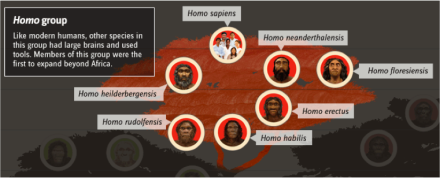By Rosie Kelley
Tuesday was a packed day for the SASA ’15 class as we spent the day exploring the Cradle of Humankind, and gaining an understanding of the ancestry we all share as humans. We toured the museum at Maropeng and went to the Sterkfontein caves, one of the most important archaeological sites in the world. After that, we enjoyed an afternoon at Lesedi Cultural Village where we celebrated the different tribes, traditions and cultures that contributed to the rich diversity we have seen in South Africa. The entire day was fascinating, however I was particularly struck by some of the things I saw in both the Maropeng Museum and the small exhibition before the Sterkfontein caves.
At the beginning of the Maropeng exhibit I was slightly disappointed. I was looking to learn new and fascinating information about the Cradle of Human kind and its origins, but it began with an explanation of human evolution. As a biology major, I cannot begin to tell you how many times I have learned that humans and chimpanzees have evolved from a common ancestor. As the exhibit continued I grew slightly more intrigued, but it was not until after going on the small boat ride that took us through the major elements of life that I found the display that truly struck me. In a display entitled “The Path to Humanity”, the various hominid group members that eventually led to the formation of the Homo sapiens species were described in detail. I initially skimmed over the visual, looking for familiar terms. After less than 30 seconds of skimming, however, I realized that something was off. Many of the Homo lineages that I learned about in detail in my Biodiversity and Population Biology classes, were missing. These are classes that are very basic requirements for the Biology Major at Elon. I also noticed that there were lineages that I had not seen before.

Figure 1 shows a detailed image of the phylogenetic tree that humans are a part of. The highlighted branch shows the Homo group in detail. This image was taken from the Smithsonian National Museum of Natural History’s website – this offers an American perspective; very similar to what I was taught at Elon. Elon University teaches the following in detail: Homo habilis, Homo erectus, Homo floresiensis, and Homo neanderthalensis. The Maropeng Museum, however, placed emphasis on an almost entirely distinct set of Homo species. Maropeng displayed Homo habilis and Homo erectus as seen in my classes and at the Smithsonian Museum, but additionally displayed Homo ergaster, Homo antecessor, Homo sapiens idaltu, and Homo heidelbergensis. The latter portion of the display is entirely different that what I have learned in my education at Elon, and this discrepancy stuck with me. Additionally, Homo ergaster, Homo antecessor, and Homo sapiens idaltu do not appear on the phylogeny published by the Smithsonian museum. One of my favorite aspects of majoring in the sciences is its fact-based nature, though I am learning that the perspectives and western training of my teachers may have an influence on the topics I once thought to be so black and white.
When we got home from the museum, I took time to research and reflect on what I had learned at Elon and what I saw in the museum. What I found is slightly disturbing to me. I learned that many of the lineages that have been emphasized in both the United States museums and in my private liberal arts education, such as Homo floresiensis and Homo neanderthalensis, are lineages that are known to have roots in both Europe and western Asia. Furthermore, lineages which received emphasis in the Maropeng museum Homo ergaster, Homo antecessor, and Homo sapiens idaltu, are all of varying regions of African descent.
I am saddened by these discrepancies from both the South African and the American end. While I understand that phylogenies are particularly difficult to create, and that scientists are still debating the exact shape of our human tree, it is saddening to know that the lineages of this tree are taught differently depending on where you are in the world. Additionally, in the theme of this course I am left evaluating both potential phylogenies to see who is missing. I am wondering if there is a separate group of Homo species that are emphasized in central / eastern Asia. This was a powerful learning experience for me, as I will approach my science-based classes with a more critical eye. Who is teaching me? Where did they receive there training? Is there potential for this topic to be slightly skewed or varied?
Image Source: http://humanorigins.si.edu/evidence/human-family-tree
